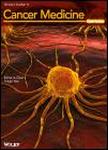版权所有:内蒙古大学图书馆 技术提供:维普资讯• 智图
内蒙古自治区呼和浩特市赛罕区大学西街235号 邮编: 010021

作者机构:Cent South Univ Dept Urol Xiangya Hosp 3 Changsha Hunan Peoples R China Cent South Univ Dept Urol Xiangya Hosp Changsha Hunan Peoples R China Ehime Univ Hosp Dept Diagnost Pathol Toon Japan Cent South Univ Dept Hlth Management Ctr Xiangya Hosp 3 Changsha Hunan Peoples R China Sun Yat Sen Univ Dept Urol Affiliated Hosp 5 Zhuhai Peoples R China
出 版 物:《CANCER MEDICINE》 (癌症医学)
年 卷 期:2018年第7卷第12期
页 面:6247-6257页
核心收录:
学科分类:1002[医学-临床医学] 100214[医学-肿瘤学] 10[医学]
基 金:National Natural Science Foundation of China [81372181, 81571432] China Scholarship Council [201606370204, 201706370135]
主 题:chemotherapy drug resistance long non-coding RNA microRNA seminoma
摘 要:The role of TDRG1 in tumorigenesis and the progression of seminoma, as well as its role in regulating chemosensitivity of seminoma to cisplatin through the PI3K/Akt/mTOR signaling pathway, has been previously defined. However, the detailed mechanism underlying TDRG1 expression and concomitant chemoresistance conditions are unknown. Furthermore, it has been reported that non-protein-coding RNAs play an important role in a variety of vital processes including cellular chemosensitivity. However, the role of non-protein-coding RNAs in regulating the chemosensitivity of seminoma remains unknown. In this study, using microarray analysis, we found that long non-coding RNA H19 was upregulated while miRNA-106b-5p was downregulated in an established cisplatin-resistant TCam-2 cell line. Moreover, H19 acts as a miRNA-106b-5p sponge and thus impairs the function of miRNA-106b-5p on its target gene, TDRG1. Based on these findings, we propose that H19 promotes the expression of TDRG1 by sequestering miRNA-106b-5p and uses this mechanism to facilitate cell survival in cisplatin-based chemotherapeutic conditions. These findings elucidate the mechanisms, at least partially, applied to deregulate TDRG1 and cisplatin sensitivity, and may provide new therapeutic possibilities for chemoresistant seminoma.